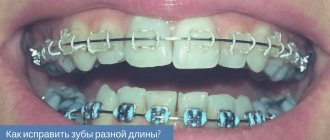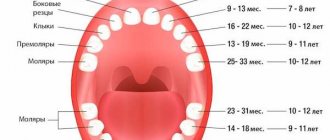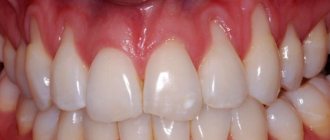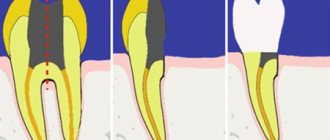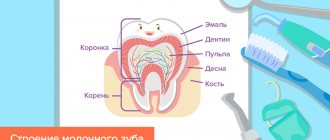The presence of milk teeth in adults cannot be attributed to the realm of fantasy or humor. This phenomenon can sometimes be encountered in dental practice. What contributes to the fact that a baby tooth can be preserved in adults and what to do with such a childhood “relic”?
Echo of childhood
Most people believe that baby teeth are closely associated with a touching and carefree childhood. It’s not for nothing that James Barry, a Scottish writer, in his fairy tale about Peter Pan - a boy who wants to always be young and not grow up - specifically describes that there were many milk pearl teeth in his mouth, and none of them had fallen out yet. Replacing baby teeth with permanent ones can be considered the same step into adulthood as the first room at school and the first two.
Teeth begin to change at about 5-6 years of age, and this process ends at about 12-14 years. Currently, according to the observations of many doctors, the replacement of baby teeth with permanent ones occurs in younger children than happened in past decades. But it also happens that baby teeth can be preserved in adults. Such cases can be encountered at 20, 30, and sometimes at 50 years of age. Why does this happen and what to do in such a situation?
Milk teeth and their features
Temporary and permanent teeth have certain differences in structure. The shape of baby teeth is the same as in molars (permanent), but their size is much smaller, the roots are shorter, and the number is different - there are only 20 of them versus 32 permanent teeth (including wisdom teeth). “Children’s” teeth are characterized by a short service life: their roots dissolve over time (as dentists say, “resorb”) approximately 2-3 years after they are fully formed. This process begins with the area touched by the crowns of the permanent teeth growing underneath them.
But it happens that for one reason or another the formation of the rudiments of permanent teeth does not occur. In this case, the roots of baby teeth are more often resorbed as a result of the influence of the rudiments of permanent adjacent teeth. But it happens that this does not happen and “children’s” teeth can then remain in adults - dentists call them persistent (translated from Latin persistere - to remain, to remain).
Why does bone tissue decrease when teeth are missing?
So, let's talk a little about the causes of bone loss.
One of the problems is the so-called bone deficiency. It is very important to understand that bone is the same living tissue of the body as all other organs, although it is very hard and has its own laws of life, growth time, etc.
The roots of the teeth are located in the bone of the alveolar process on the upper jaw and in the alveolar part on the lower jaw, they provide the retention and stability of the teeth. When we talk about bone deficiency, we mean the partial or complete absence of that bone tissue.
The alveolar bone has such a structure and structure that in the absence of teeth it simply dissolves or resorption occurs. Also, bone loss can occur with periodontal disease, even in the presence of teeth.
Removable dentures greatly increase the rate of alveolar bone resorption due to large or improper pressure on the gum and bone, pressure for which they were not designed.
All this can lead to the fact that there will be nowhere to place dental implants.
Why may there be no rudiments of permanent teeth?
There are a variety of reasons that contribute to the absence of permanent tooth buds. These include hereditary characteristics, osteomyelitis of the jaws and their traumatic lesions, metabolic disorders, pathology of the endocrine glands. In addition, acute and chronic inflammation of baby teeth, in particular, untreated periodontitis in a timely manner, can also damage the rudiments of permanent teeth and contribute to their death.
Sometimes it happens that the rudiments of permanent teeth are formed, but can lie quite deep without touching the roots of milk teeth. This may occur due to the incorrect position of the permanent tooth or lack of space. In such cases, baby teeth can also be found in adults.
Problems that accompany the loss of chewing teeth
The absence of teeth primarily affects the inability to eat properly. If teeth are removed only on one side, then an increased load falls on the other, which means that the jaw joint is overloaded in a certain area, a crunch appears when the jaw moves, headaches develop, and over time, facial asymmetry may occur. If teeth are missing on only one jaw, then those located on the opposite jaw begin to shift, i.e. fall out of the sockets because they do not receive full support from the antagonist teeth. Naturally, bone tissue atrophy occurs in the area of missing teeth, which remains without the natural chewing load.
The absence of chewing teeth also entails aesthetic disturbances. Even if the defect is not noticeable when smiling, the cheeks become sunken and a large number of wrinkles form. Problems of the digestive tract also arise, especially if chewing teeth are missing on both sides at once - this is the result of inadequate and poor-quality chewing of food and a transition to softer foods.
Do adults need to have their baby teeth removed?
Undoubtedly, baby teeth can often cause problems in adults. Firstly, their service life is short, which is why their resistance to caries is much lower compared to permanent ones. Secondly, teeth that do not fall out on time can interfere with the growth of permanent teeth and also cause them to be incorrectly positioned. But this does not mean that if a baby tooth is found in an adult, it must be removed. Everything is individual and depends on the specific situation. Very often, it is recommended to leave baby teeth in adults that are well preserved so that they last as long as they can. After all, sometimes it happens that permanent teeth may never appear in their place.
In any case, what to do with a baby tooth in adults needs to be decided after an X-ray examination is carried out, which will help determine the presence or absence of the rudiments of an unerupted permanent tooth, as well as whether the process of resorption of the baby tooth root is ongoing. If the rudiments are not found and the roots of a baby tooth have not been reabsorbed, and it looks aesthetically pleasing and immobile, then such a baby tooth should not be removed. The same applies to cases where it is X-ray proven that the position of the permanent tooth is such that even after removing the milk tooth, it will not be able to erupt. However, in this case it is better to consult an orthodontist.
Treatment
At an early age, treatment is aimed at actively stimulating proper growth and formation of teeth, as well as diagnosing and preventing their deformation.
Once the main 7 permanent teeth have erupted, you can begin to think about replacing missing ones. In most cases, such treatment is preceded by special preparation carried out by the orthodontist, and then subsequent procedures to restore the missing tooth.
Treatment methods:
- Dental prosthetics using metal-plastic or zirconium oxide-based crowns;
- Adhesive bridge;
- Dental implantation;
For example, with symmetrical defects (no fangs), the doctor may suggest moving the nearest teeth in place of the missing ones to replace them. It is possible to transform nearby teeth (premolars) into fangs by applying a special photopolymer-based material to them. But, in the field of dental treatment, this is aerobatics, which is not accessible to everyone. And now we are not talking about the financial situation, you also need to find an experienced doctor, namely a restorative orthodontist.
Removable prosthetics and implants will help in the fight against edentia
In case of complete secondary adentia (when teeth are completely missing), treatment methods can only be removable prosthetics or, in some cases, installation of implants. Partial secondary adentia can be treated by so-called “ orthodontic preparation ”, in simple terms - prosthetics.
What to do if a baby tooth can cause problems?
If you are not satisfied with the aesthetics of a baby tooth or it is mobile, you still need to start with an x-ray examination. Having discovered on an x-ray that there are no rudiments of a permanent tooth, and the roots of a baby tooth have been reabsorbed, and mobility of the 3rd - 4th degree is observed (the tooth is very mobile), then it needs to be removed and then a decision must be made about what type of prosthetics to use in this case. case.
If you are not satisfied with the appearance of the tooth, you also need to use an x-ray to determine the condition of the roots of the baby tooth and the rudiments of the permanent tooth. Further, the decision must be made individually in a specific case. It depends on the age of the patient, as well as on the place of the baby tooth in the dentition. If there are no rudiments and the roots of a baby tooth are present, a veneer can be installed on it or the tooth can be restored, making it invisible in the dentition. Those who want to completely transform their smile will benefit from Lumineers.
If there are rudiments of a permanent tooth, you need to estimate how long it will take before erupting and decide to remove the baby tooth and pull out the permanent one.
Although the presence of baby teeth in adults can be considered an anomaly, this is not a reason to part with them - after all, very often they can serve you for many years. But sometimes it happens that such “greetings from childhood” can become an obstacle to the eruption of a permanent tooth. Therefore, if you discover that you have a baby tooth, be sure to take an x-ray and consult a specialist.
Causes of edentia
The first cause of adentia is periodontitis.
The second cause of edentia is caries.
The third reason for tooth loss is pulpitis
The fourth cause of adentia is periodontitis.
The fifth possible cause of adentia is hypoplasia
The most common thing is the lack of proper oral hygiene and care.
There are three diseases that provoke tooth loss - periodontitis (soft tissue diseases), caries and its complications (pulpitis and periodontitis) and hypoplasia (underdevelopment of tooth tissue, most often enamel).
There are other reasons for tooth loss - due to a blow or some complex disease - but such cases are exceptions to general practice, so we will not dwell on them in detail.
The main reason leading to tooth loss is, after all, a lack of proper attention to one’s health and letting the first signs of illness take their course.
There is no consensus or single way to prevent caries or periodontitis; the occurrence of these diseases can be influenced by various factors - genetic predisposition, poor nutrition, poor hygiene and even the area of residence. But timely diagnosis and proper treatment always save the patient from many further health problems.
Molar tooth hurts
After the molar has emerged from the gums, the “young” tooth enamel is not fully saturated with all the necessary microelements. During this period, the tooth is especially vulnerable: it is strictly forbidden to subject it to overload. It is not for nothing that children are advised not to chew, for example, candy, large quantities of peanuts, or any solid foods. If you neglect this rule, children may immediately develop caries, and this is the path to problems with specific teeth. Caries gradually turns into pulpitis (damage to the internal cavity of the tooth) and periodontitis (damage to the ligaments surrounding the tooth). The child often experiences toothache and poor general health. Without turning to a professional doctor for help in time, parents can lead their child to various consequences - up to the complete loss of a diseased tooth. If a predisposition to the appearance of carious lesions has been identified, their prevention may involve closing the natural deep pockets surrounding the molars. This is done using high-quality composite materials. In this case, food debris will not accumulate in these places, destructive microflora will not develop, and the period of susceptibility to caries will pass when the teenager grows up.

